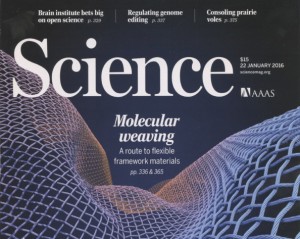I am sure that there are small numbers of chemists and materials scientists who weave for a hobby and for relaxation, but when I read the article in Science (22 January 2016) discussed here, I suspected that I would be rare if not unique in being equipped to explain this remarkable chemical synthesis to my weaver friends!
I hope that I can do justice to both communities. I tend to view the Straw Sandal Project website as a place on the web for biologists who never quite got over wanting to be anthropologists and for weavers and shoe designers looking for inspiration. But it turns out this biologist majored in chemistry at a small college in Virginia, Hampden-Sydney College with only 500 students at the time and a chemistry department that was small in size but large in opportunities to learn and grow as a scientist. So, even though I have not read a hard core chemistry research report in years, thanks to some great teachers years ago, I had no problem with the organic and inorganic chemistry in the report by Y. Liu et al. on page 365 titled “Weaving of organic threads into a crystalline covalent organic framework”.
In some ways, it was more challenging to open the pages of Irene Emery’s classic The Primary structure of Fabrics and begin searching for similar weaves and nomenclature. How many chemists I wonder have a copy of Irene Emery’s opus within arm’s reach! Science devoted a very nice cover to the story. The cover was described as an “Illustration of woven molecular fabric.”
 My thought was, OK how will my weaver friends see this? I think Irene would agree that this construction is a balanced plain weave with the warps and wefts made of the same material. So far so good. But what about the thread (some would say yarn, but I think the chemists are good with using the term thread). I would call it plied thread composed of Z-twisted elements. Oops, this is not what the chemists made. They used a copper I cation to bind two identical organic molecules. Four nitrogen atoms, two from each organic molecule formed a reversible coordination complex with the cation. The organic molecules, think of each as a short piece of thread, are held in just the right position so that they cross or interlace.
My thought was, OK how will my weaver friends see this? I think Irene would agree that this construction is a balanced plain weave with the warps and wefts made of the same material. So far so good. But what about the thread (some would say yarn, but I think the chemists are good with using the term thread). I would call it plied thread composed of Z-twisted elements. Oops, this is not what the chemists made. They used a copper I cation to bind two identical organic molecules. Four nitrogen atoms, two from each organic molecule formed a reversible coordination complex with the cation. The organic molecules, think of each as a short piece of thread, are held in just the right position so that they cross or interlace.
My weaver friends are going to want to know if a loom was used. I think that this copper 1 coordination complex is a molecular loom. Think of the two organic molecules as threads attached to a loom like warps strung on a typical weaving loom in preparation for weaving. To extend the threads, the chemist adds a small linear reactive molecule, an imine in this case. The imines attach to the four ends of the two threads on the molecular loom if you will. Now the other reactive ends of the imines are still available to add another molecular thread to each one, so the weaving starts by extending the length of the original threads. Or alternatively, another molecular loom can be added to each free end of the imine group. At the end of the molecular weaving, the copper cation can be released and so the molecular loom is essentially released from the tiny piece of woven molecular material. If you look at the cover image, you can see where each tiny loom was situated. Wherever the two threads interlace is where the copper 1 coordination complex, the molecular loom, was set up. So there are many tiny looms at work at the same time to weave a molecular textile. Each crossover point marks the place where a molecular loom set up a starting place with two molecular threads oriented for weaving in four different directions.
How will this new kind of woven material be used? Certainly a major use will be in nano-scale (a nanometer is one billionth of a meter, if you can visualize that: I cannot!) machines to create special environments for chemical reactions or to create surfaces on which to organize mechanical tasks. Another idea presented in a perspectives article titled “Interlacing molecular threads” by Enrique Gutierrez-Puebla in the same issue of Science is that these materials may be considered as molecular sponges capable of sopping up metal ions in liquid waste. An idea that popped into my mind as I was reading an article on new ways to restore and protect works of art, especially out of doors, such as murals and mosaics, may be to cover them with just the right kind of molecular woven material tailored to counteract corrosive chemicals specific to the environment of each piece. See article on recent restoration techniques.
One final observation is that most of the authors of the scientific paper are Asian scientists. I wonder if in China and Japan they wore and played with woven baskets and scandals. Did early contact with woven materials influence their creative thinking about approaches to molecular weaving?